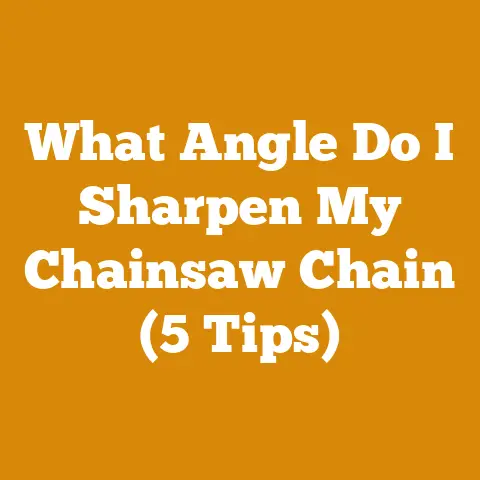which way does the chainsaw blade go (Important!)
Which Way Does the Chainsaw Blade Go (Important!)(Explained)
Have you ever watched a chainsaw in action and thought, “Wow, that’s a tool with a mind of its own!”?
That’s exactly how I felt when I first got my hands on one.
The sheer power, the roar of the engine—it’s like taming a wild beast.
But the real question that puzzled me, and perhaps you too, was: Which way does the chainsaw blade go? Let’s journey through this together.
A Stroll Down Memory Lane
I remember my first day as a rookie in the lumber industry.
I was eager, maybe too eager, to show off my skills.
I had just replaced the chain on my chainsaw and was ready to impress.
But as I fired it up, the saw seemed to be chewing rather than cutting.
My mentor chuckled and pointed out my obvious mistake: I had installed the chain backward!
It was a lesson learned with a blush on my cheeks and a vow never to repeat it.
Why Direction Matters
Before we unravel the mechanics, let’s understand why it’s crucial to get the direction right.
A chainsaw cuts with precision when the cutting teeth face forward on the top side of the bar.
Think of it as a train on tracks; if the train faces backward, it won’t reach its destination smoothly.
The same goes for our trusty chainsaw.
Safety First!
IMPORTANT: Never work on your chainsaw while it’s running.
Always turn it off and disconnect from any power source.
Safety goggles and gloves should be your constant companions.
Gearing Up: Equipment You’ll Need
- Chainsaw (naturally!)
- Replacement chain (if needed)
- Appropriate wrench or screwdriver
- Safety gloves
- Goggles
Prerequisite Knowledge
Familiarize yourself with your specific chainsaw model.
Manuals are your friend; they’ll guide you through unique features and specific instructions you need to know before diving into adjustments.
Step-by-Step Guide to Installing a Chainsaw Blade
- Ensure Safety First
Begin by ensuring that your chainsaw is completely off and disconnected from any power source.
This is non-negotiable for safety. - Remove the Protective Cover
Use a wrench or screwdriver to unscrew the nuts or bolts securing the cover.
This will reveal the chain and bar. - Detach the Old Chain
Carefully slide off the old chain from the bar.
Take a mental note of its orientation for reference. - Examine Bar and Chain
Inspect both for wear or damage.
A well-maintained bar can make all the difference. - Position the New Chain
Fit the new chain onto the bar, ensuring that the sharp edges face forward on top.
The drive links must align perfectly within the bar groove. - Secure the Cover Back
Once satisfied with the placement, replace and tighten the cover securely over the chain and bar. - Adjust Chain Tension
Use the tension screw to adjust until the chain moves smoothly without sagging. - Conduct a Final Check
Double-check all components for security and correct positioning before operating your chainsaw.
Delving Into Advanced Techniques
Sharpening Your Chain
A sharp chain is essential for efficient cutting and safety.
Here’s how I sharpen mine:
- Get a Round File
Match it with your chain size for uniform sharpening. - Secure Your Chainsaw
Use a vice to hold it steady while sharpening. - File at the Right Angle
Maintain an angle of 25-30 degrees for optimal sharpness. - Consistent Strokes
Apply gentle, consistent strokes for each tooth, ensuring even sharpening across the chain.
Balancing Your Chainsaw
Ever noticed your chainsaw vibrating excessively? This could indicate an imbalance.
- Inspect Components
Check if all parts are securely fastened and in good condition. - Check Chain Tension
A loose or overly tight chain can cause imbalance. - Lubrication
Ensure all moving parts are well lubricated to reduce friction-induced vibrations.
Common Missteps and Concerns
What if I Install It Backward?
No worries!
If this happens, simply turn off your chainsaw, double-check your setup against the direction guide, and reposition accordingly.
It’s a common mistake even among seasoned users.
How Often Should I Change My Chain?
This depends on usage frequency and conditions.
Regular inspection is key; if you notice decreased performance or significant wear, it may be time for a change.
Handling Difficult Cuts
Encountering tough wood?
Ensure your chain is sharp and properly tensioned, and apply steady pressure without forcing it.
Troubleshooting Tips and Tricks
- Chain Keeps Slipping Off:
Often due to improper tension; readjust until snug. - Saw Not Cutting Properly:
Check chain orientation and sharpness; both are critical for effective cutting. - Excessive Smoke:
Could be poor lubrication—check oil levels and adjust tension if necessary.
Best Practices for Chainsaw Maintenance
Keep your tool in top shape with these practices:
- Regular cleaning to prevent debris buildup
- Frequent lubrication to minimize wear
- Storing in a dry, safe environment to prevent rust
Important Reminders Before You Go
- Safety over speed—always.
- Verify your work before operating your chainsaw.
- Routine maintenance enhances longevity and performance.
FAQs Section
Q: Can I use any chain for my saw?
Nope!
Always use chains that match your saw’s specifications for optimal safety and performance.
Q: How do I know when my chain needs sharpening?
If your chainsaw produces sawdust rather than wood chips while cutting, it’s likely time for sharpening.
Q: My chainsaw emits smoke—is this normal?
No, this typically indicates lubrication issues or incorrect tensioning that need addressing immediately.






